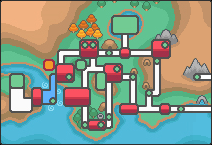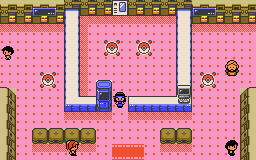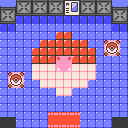Battle Tower (Generation II)
- Battle Tower (Johto) redirects here. For the Battle Tower located at the Johto Battle Frontier, see Battle Tower (Sinnoh).
| ||||
| ||||
| Location: | West of Olivine CityC | |||
|---|---|---|---|---|
| Region: | Johto | |||
| Generations: | II | |||
 Location of Battle Tower in Johto. | ||||
| Pokémon world locations | ||||
The Battle Tower (Japanese: バトルタワー Battle Tower) in Generation II was the first Battle Tower in the Pokémon games, debuting in Pokémon Crystal. It is Johto's premiere battle facility, located at the northernmost part of Route 40, west of Olivine City.
As the first Battle Tower in the series, it introduced many of the special rules that would later be expanded upon for Battle Towers introduced later. One addition, introduced in Pokémon Emerald, that the Battle Tower in Crystal lacks is a leader who is in charge of the Battle Tower. Another difference with later Battle Towers is that the Battle Tower in Pokémon Crystal is built on the same landmass as the rest of the region and may be challenged before the player has become the Champion. The Battle Tower in Crystal also allows any Legendary Pokémon to participate, though later generations would ban many of them.
In the Japanese version of Pokémon Crystal, the Battle Tower utilizes the Mobile System GB.
In the games
The original Battle Tower established the basic rules of all Battle Tower challenges. Later Battle Towers would modify some of these basic rules to be somewhat more restrictive.
Its slogan is Take the Ultimate Trainer Challenge! (Japanese: 「めざせ! さいきょう トレーナー」 Become the Strongest Trainer!).
Access
Japanese version
In the Japanese version of Pokémon Crystal, the Battle Tower is unlocked once the player connects to Mobile System GB for the first time, which requires the Mobile Game Boy Adapter. While the Battle Tower is locked, its doors display the message "The BATTLE TOWER's doors are closed…" (「バトルタワーの いりぐちは しまってる⋯」). After being unlocked, they instead return the message "It's open!" (「あいてる!」).
Since the discontinuation of the Mobile System GB in 2002, it is no longer possible to unlock the Battle Tower in the Japanese version of Pokémon Crystal. The Battle Tower is also inaccessible in the Virtual Console version.
Western language versions
In the Western language versions of Pokémon Crystal, the Battle Tower is always accessible (even in the Virtual Console version). The doors can no longer be interacted with, so the localized messages from the Japanese version are unused.
Challenges
Battle Tower challenges are made by entering three of the player's Pokémon with the attendant at the front desk. The attendant will then guide the player to a special room where they will battle against seven opponents in a row, healing between each battle. After the seven Trainers have been defeated, the player will be rewarded with five of a stat-increasing nutritious drink.
Restrictions
The Battle Tower has several restrictions aside from the amount of Pokémon that can be entered.
- All Pokémon must be less than or equal to the level of battle challenged. Levels are in intervals of 10, and the player can only choose levels 60 to 100 after entering the Hall of Fame.
- No two Pokémon can be holding the same item.
- Items cannot be used by Trainers on their Pokémon.
- Mewtwo, Mew, Lugia, Ho-Oh, and Celebi are only allowed to be entered if the level chosen is 70 or higher. Eggs are not allowed to enter.
Unobtainable Pokémon
Certain Pokémon cannot normally be obtained at lower enough levels to enter low-level challenges (e.g. Dragonite and Zapdos cannot be legitimately obtained at level 10). However, the game does not validate whether a Pokémon is legitimately obtainable at a specific level.
Prizes
| Item | Location | Games | |
|---|---|---|---|
| Calcium ×5 | For winning 7 battles in a row | C | |
| Carbos ×5 | For winning 7 battles in a row | C | |
| HP Up ×5 | For winning 7 battles in a row | C | |
| Iron ×5 | For winning 7 battles in a row | C | |
| Protein ×5 | For winning 7 battles in a row | C | |
Japanese Crystal
In Japanese Crystal, the Battle Tower is directly associated with the Mobile System GB. Further multiplayer features are available, including mobile battles, for which a small price is charged on the players' mobile phones. If the player battled well enough, they could become a Room Leader (Japanese: ルームリーダー Room Leader). All Room Leaders would be registered in the Honor Roll of the Mobile Center for posterity.
Trainers
The following Trainers may appear during the Battle Tower challenge. All of them use randomly-determined teams, depending on the level of the selected challenge.
Layout
| Version | 1F | Elevator | Hallway | Battle Arena |
|---|---|---|---|---|
| Crystal | 
|

|

|

|
In the anime

The Battle Tower made a cameo appearance in Fight for the Light!, where Team Rocket mistook it for an office building and tried to get in, but to no avail as the security officers asked for Gym Badges.
In the manga

Pokémon Adventures
Gold, Silver & Crystal arc
In Querulous Qwilfish, the Battle Tower was under construction and was due to be finished in a month. A tank that was collecting waste from the construction cracked under pressure, spilling its contents into the sea nearby and contaminating the water. As a result, Qwilfish attacked a worker and Crystal out of anger and to protect a baby Qwilfish that became sick due to the pollution. It was also where Suicune first appeared, purifying the water and curing the baby Qwilfish in the process.
In Popular Pupitar, Silver was revealed to have first met Lance at the Johto Battle Tower construction site, wanting to question him if he knew anything about the giant bird Pokémon that the Masked Man had used to kidnap him nine years earlier.
Platinum arc
In Deprogramming Porygon-Z, Platinum mentioned the Johto Battle Tower (as well as the Hoenn Battle Tower) when she was explaining the Sinnoh Battle Tower.
Trivia
- In Pokémon Crystal, several Trainers are references to its development staff.[1]
- Guitarist Masuda is a reference to Junichi Masuda, the game's music director.
- Bug Catcher Tajiri is a reference to Pokémon's creator, Satoshi Tajiri, and his childhood fixation with bug catching.
- Scientist Mori and Teacher Kawakami are, respectively, a reference to Akito Mori and Naoko Kawakami, who are listed under "special thanks" in the credits.
In other languages
| ||||||||||||||||||||||||||||||||||||
References
| Johto | ||||||||
|---|---|---|---|---|---|---|---|---|
|
| ||||||||
|

|
This article is part of Project Locations, a Bulbapedia project that aims to write comprehensive articles on every location in the Pokémon world. |

































